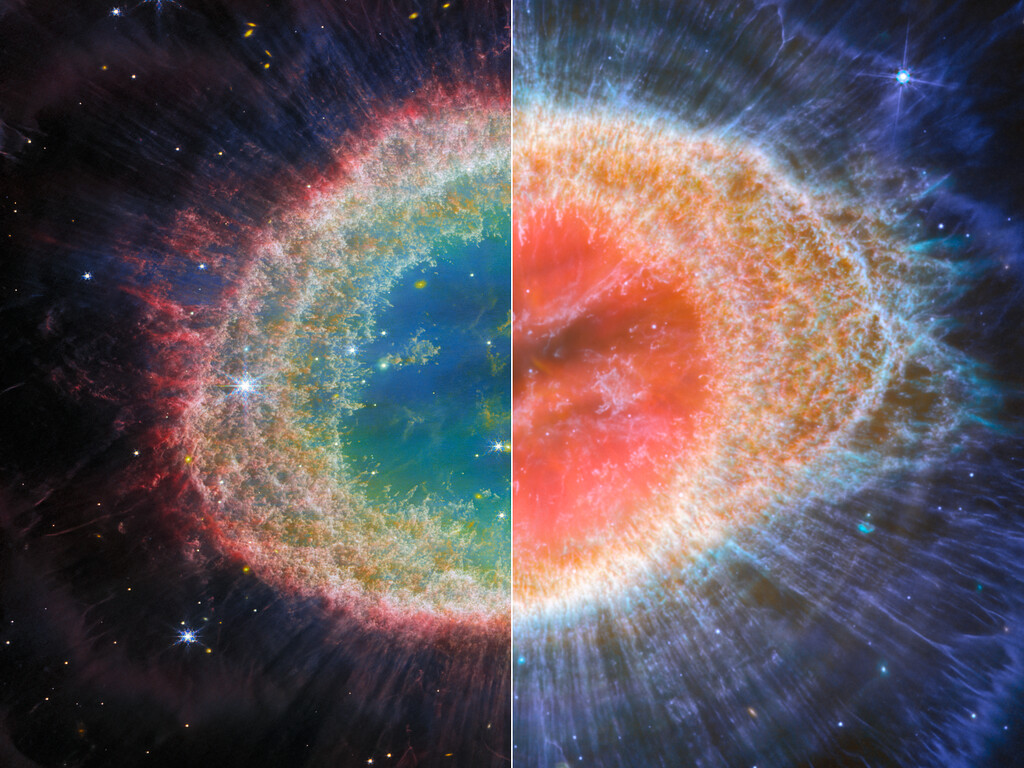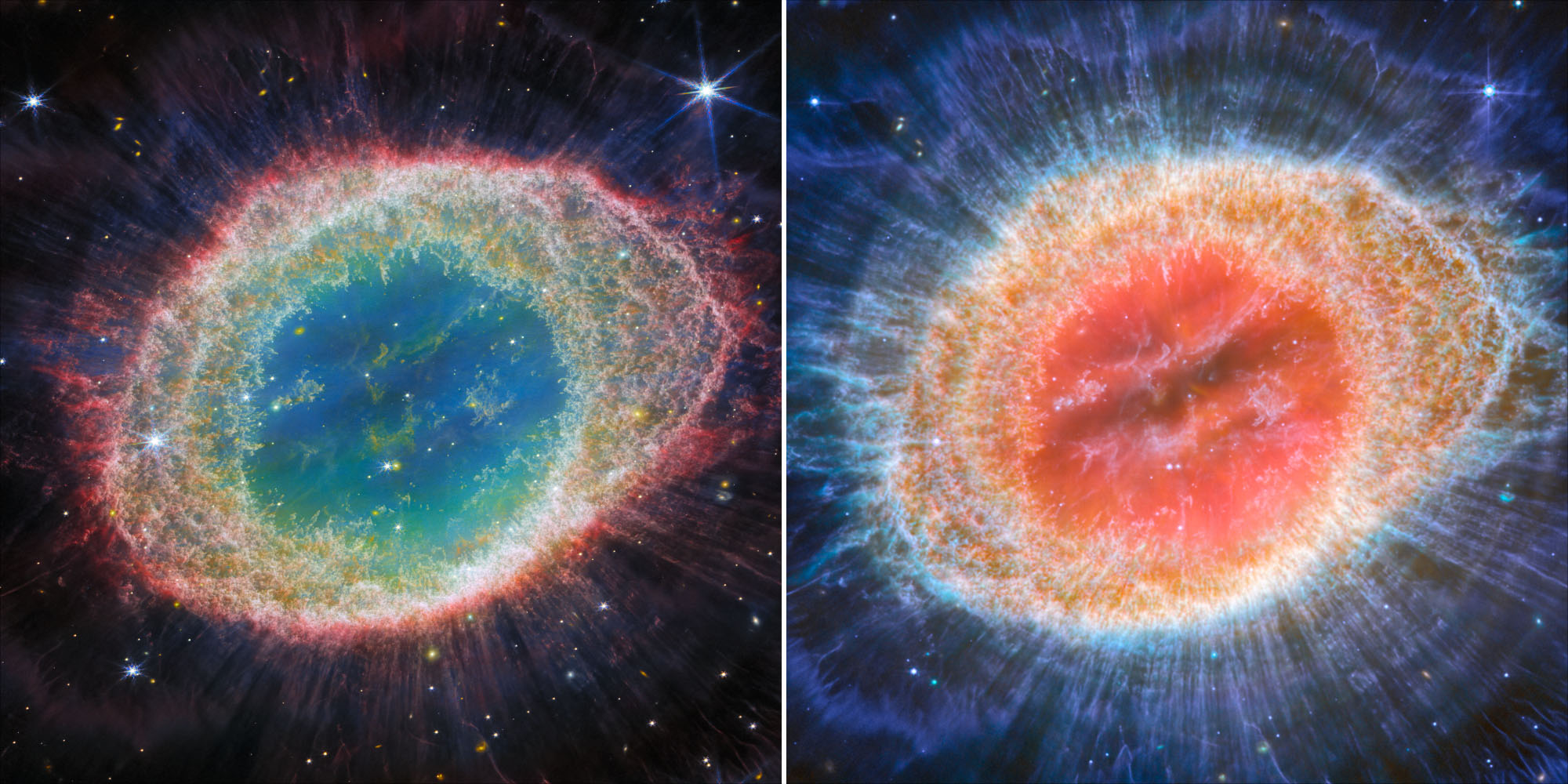James Webb Space Telescope offers a mesmerizing look at the Ring Nebula (photos)
"When we first saw the images, we were stunned by the amount of detail in them."

Approximately 2,200 light-years from where you're sitting lie the Cheerio-shaped remains of a dying star — remnants that form a structure famously known as the Ring Nebula. And on Monday (Aug. 21), scientists announced the James Webb Space Telescope has struck gold once again, earning a rather beautiful new view on this iconic cosmic halo.
"When we first saw the images, we were stunned by the amount of detail in them. The bright ring that gives the nebula its name is composed of about 20,000 individual clumps of dense molecular hydrogen gas, each of them about as massive as the Earth," Roger Wesson of Cardiff University said in a statement.
Not to be confused with one of the JWST's very first images, the Southern Ring Nebula, the Ring Nebula (also known as Messier 57) is considered one of the greatest examples of a planetary nebula we have so far. One might argue, however, that "planetary nebula" is a bit of a misleading term for this light-year-wide spectacle. It has nothing to do with planets, really. Planetary nebulas are basically regions of cosmic gas and dust formed from the outer shells of dying stars, in this case a quite spherical and sun-like one.
"Planetary nebulas were once thought to be simple, round objects with a single dying star at the center. They were named for their fuzzy, planet-like appearance through small telescopes," Wesson said. "Only a few thousand years ago, that star was still a red giant that was shedding most of its mass. As a last farewell, the hot core now ionizes, or heats up, this expelled gas, and the nebula responds with colorful emission of light."
Related: James Webb Space Telescope reveals the colorful Ring Nebula in exquisite detail (photos, video)
What did the JWST find?
If you're wondering what you're looking at here, first of all, the European Space Agency (ESA) painted a wonderful picture of the angle at which we see the Ring Nebula.
In this new image, we're gazing almost directly down one of the structure's poles, the agency explained, and the brightly colored barrel of material is pointed away from it. Keep in mind that, in reality, this scene is in three dimensions. So at the center of this nebula, which ESA likens to a "distorted doughnut," there's a ton of lower density material packed within. That stuff is also pointed away from us.
Get the Space.com Newsletter
Breaking space news, the latest updates on rocket launches, skywatching events and more!
In the middle of the whole structure lies a star on its way to its ultimate fate. It will soon become a white dwarf, also known as a corpse star. White dwarfs get that grim name because they represent the final stage of stellar evolution.
While this stellar death process is happening, the dying star sort of seems to be ejecting its outer shells of gas, which is what's causing the vibrant "ring" part of the Ring Nebula seen in the new JWST image.
With its state-of-the-art army of infrared sensors, the JWST managed to obtain images that provide "unprecedented spatial resolution and spectral sensitivity" regarding all that cosmic chaos, according to ESA's statement. What this means is the spaceborne telescope, which sits about a million miles (1.6 million km) from Earth, was able to reveal details about the Ring Nebula's intricate structure that scientists simply haven't parsed before.

For instance, by capturing infrared light wavelengths emitted by the nebula, otherwise known as light wavelengths invisible to the human eye, the JWST unveiled information about the inner ring's filament structure as well as approximately ten concentric "arcs" in outer regions of the phenomenon. Those target-shaped features actually came as a surprise.
"These arcs must have formed about every 280 years as the central star was shedding its outer layers," Wesson said. "When a single star evolves into a planetary nebula, there is no process that we know of that has that kind of time period. Instead, these rings suggest that there must be a companion star in the system, orbiting about as far away from the central star as Pluto does from our sun."
"As the dying star was throwing off its atmosphere, the companion star shaped the outflow and sculpted it," Wesson offered as an explanation, highlighting that "no previous telescope had the sensitivity and the spatial resolution to uncover this subtle effect."
The JWST's superpowers
On that note, these findings nicely emphasize that the promise of this machine, once an ambitious dream, has absolutely been realized.
In a nutshell, the JWST's job is to show us things in the universe illuminated in the infrared region of the electromagnetic spectrum; things far beyond the capacity of our unaided eyes and, actually, beyond some of our most powerful instruments.
"We realized that Webb observations would provide us with invaluable insights, since the Ring Nebula fits nicely in the field of view of Webb’s NIRCam (Near-Infrared Camera) and MIRI (Mid-Infrared Instrument) instruments," Wesson said.
With the JWST, the team was able to notice some "curious spikes" pointing directly away from the central star within the ring. These so-called spikes were apparently only faintly visible in images taken by the Hubble Space Telescope. "We think these could be due to molecules that can form in the shadows of the densest parts of the ring, where they are shielded from the direct, intense radiation from the hot central star," Wesson said.
To get into some more technical aspects of the findings, Wesson explains that the team identified a narrow band of emission coming from some molecules within the ring known as polycyclic aromatic hydrocarbons, or PAHs. PAHs are basically carbon-bearing molecules, but importantly for these new JWST results, they were not expected to form within the nebula studied.
It's also worth noting that this isn't the first time the JWST has pointed its hexagonal gold eyes toward the Ring Nebula. Very recently, the machine imaged this pocket of the universe in high-resolution, and scientists added mesmerizing green and purple filters to create a pretty glorious scene for us to admire.
Such imaging also helped experts learn more about the nebula's intricate details
As for what's next, Wesson says a big question that has risen from these new JWST observations is how a regular old, spherical star managed to form a nebula as ornate as this one. Wesson's theory about the star having a companion object helper seems to be a good one so far – but only time will tell whether that's truly the case. The JWST certainly has its hands full.
Join our Space Forums to keep talking space on the latest missions, night sky and more! And if you have a news tip, correction or comment, let us know at: community@space.com.

Monisha Ravisetti is Space.com's Astronomy Editor. She covers black holes, star explosions, gravitational waves, exoplanet discoveries and other enigmas hidden across the fabric of space and time. Previously, she was a science writer at CNET, and before that, reported for The Academic Times. Prior to becoming a writer, she was an immunology researcher at Weill Cornell Medical Center in New York. She graduated from New York University in 2018 with a B.A. in philosophy, physics and chemistry. She spends too much time playing online chess. Her favorite planet is Earth.









